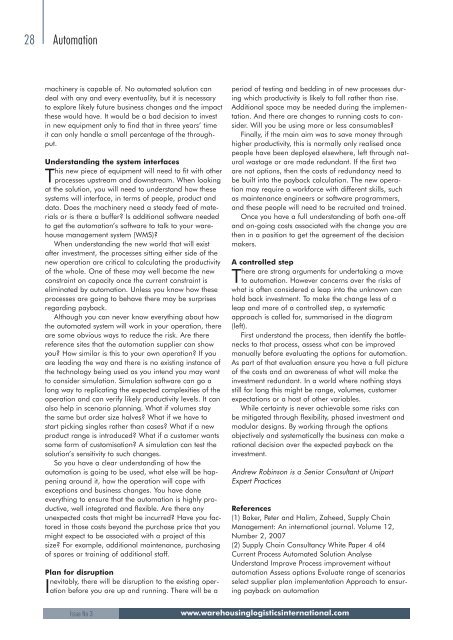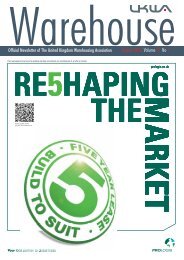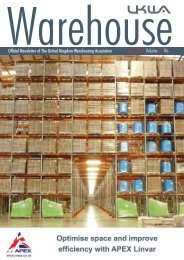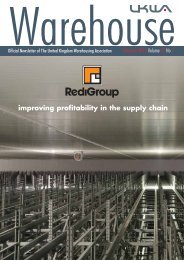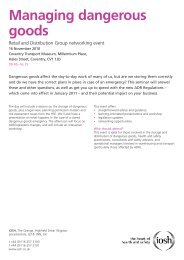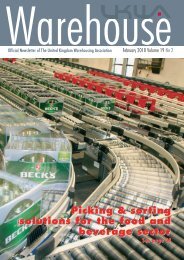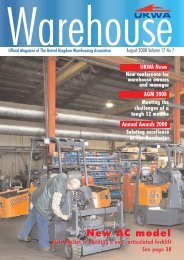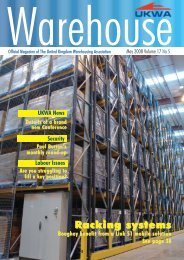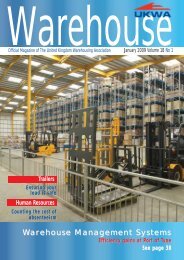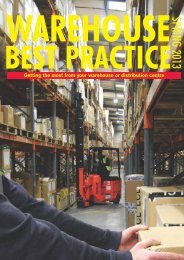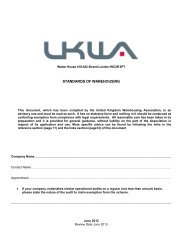ifwla - Warehousing and Logistics International
ifwla - Warehousing and Logistics International
ifwla - Warehousing and Logistics International
- No tags were found...
You also want an ePaper? Increase the reach of your titles
YUMPU automatically turns print PDFs into web optimized ePapers that Google loves.
28 Automationmachinery is capable of. No automated solution c<strong>and</strong>eal with any <strong>and</strong> every eventuality, but it is necessaryto explore likely future business changes <strong>and</strong> the impactthese would have. It would be a bad decision to investin new equipment only to find that in three years’ timeit can only h<strong>and</strong>le a small percentage of the throughput.Underst<strong>and</strong>ing the system interfacesThis new piece of equipment will need to fit with otherprocesses upstream <strong>and</strong> downstream. When lookingat the solution, you will need to underst<strong>and</strong> how thesesystems will interface, in terms of people, product <strong>and</strong>data. Does the machinery need a steady feed of materialsor is there a buffer? Is additional software neededto get the automation’s software to talk to your warehousemanagement system (WMS)?When underst<strong>and</strong>ing the new world that will existafter investment, the processes sitting either side of thenew operation are critical to calculating the productivityof the whole. One of these may well become the newconstraint on capacity once the current constraint iseliminated by automation. Unless you know how theseprocesses are going to behave there may be surprisesregarding payback.Although you can never know everything about howthe automated system will work in your operation, thereare some obvious ways to reduce the risk. Are therereference sites that the automation supplier can showyou? How similar is this to your own operation? If youare leading the way <strong>and</strong> there is no existing instance ofthe technology being used as you intend you may wantto consider simulation. Simulation software can go along way to replicating the expected complexities of theoperation <strong>and</strong> can verify likely productivity levels. It canalso help in scenario planning. What if volumes staythe same but order size halves? What if we have tostart picking singles rather than cases? What if a newproduct range is introduced? What if a customer wantssome form of customisation? A simulation can test thesolution’s sensitivity to such changes.So you have a clear underst<strong>and</strong>ing of how theautomation is going to be used, what else will be happeningaround it, how the operation will cope withexceptions <strong>and</strong> business changes. You have doneeverything to ensure that the automation is highly productive,well integrated <strong>and</strong> flexible. Are there anyunexpected costs that might be incurred? Have you factoredin those costs beyond the purchase price that youmight expect to be associated with a project of thissize? For example, additional maintenance, purchasingof spares or training of additional staff.Plan for disruptionInevitably, there will be disruption to the existing operationbefore you are up <strong>and</strong> running. There will be aperiod of testing <strong>and</strong> bedding in of new processes duringwhich productivity is likely to fall rather than rise.Additional space may be needed during the implementation.And there are changes to running costs to consider.Will you be using more or less consumables?Finally, if the main aim was to save money throughhigher productivity, this is normally only realised oncepeople have been deployed elsewhere, left through naturalwastage or are made redundant. If the first twoare not options, then the costs of redundancy need tobe built into the payback calculation. The new operationmay require a workforce with different skills, suchas maintenance engineers or software programmers,<strong>and</strong> these people will need to be recruited <strong>and</strong> trained.Once you have a full underst<strong>and</strong>ing of both one-off<strong>and</strong> on-going costs associated with the change you arethen in a position to get the agreement of the decisionmakers.A controlled stepThere are strong arguments for undertaking a moveto automation. However concerns over the risks ofwhat is often considered a leap into the unknown canhold back investment. To make the change less of aleap <strong>and</strong> more of a controlled step, a systematicapproach is called for, summarised in the diagram(left).First underst<strong>and</strong> the process, then identify the bottlenecksto that process, assess what can be improvedmanually before evaluating the options for automation.As part of that evaluation ensure you have a full pictureof the costs <strong>and</strong> an awareness of what will make theinvestment redundant. In a world where nothing staysstill for long this might be range, volumes, customerexpectations or a host of other variables.While certainty is never achievable some risks canbe mitigated through flexibility, phased investment <strong>and</strong>modular designs. By working through the optionsobjectively <strong>and</strong> systematically the business can make arational decision over the expected payback on theinvestment.Andrew Robinson is a Senior Consultant at UnipartExpert PracticesReferences(1) Baker, Peter <strong>and</strong> Halim, Zaheed, Supply ChainManagement: An international journal. Volume 12,Number 2, 2007(2) Supply Chain Consultancy White Paper 4 of4Current Process Automated Solution AnalyseUnderst<strong>and</strong> Improve Process improvement withoutautomation Assess options Evaluate range of scenariosselect supplier plan implementation Approach to ensuringpayback on automationIssue No 3www.warehousinglogisticsinternational.com


